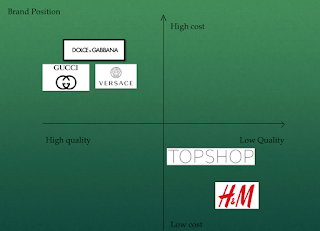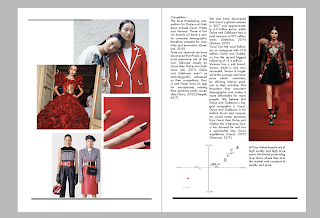Dolce & Gabbana Abaya 2016 ready to wear
Links:
https://www.vogue.co.uk/article/dolce-and-gabbana-hijab-and-abaya-collection
https://www.theguardian.com/commentisfree/2016/jan/11/dolce-gabbana-hijab-collection-muslim-women-western-fashion
Dolce & Gabbana launched their first ever Abaya collection in 2016, this is for a very different audience type for the brand and is extending their consumer demographic. This collection was aimed at muslim consumers with a range of abayas and hijabs in its signature colourful prints.
The prints included flowers, fruits and polkadots, constructed in delicate silks whilst others are comprised of neutral lace and satin - all demonstrating the dramatic femininity that the brand has built its name on.
A number of luxury brands are making moves to target the Muslim market, particularly as growth in retail in the Arab world outpaces that in Asia and Russia. Many labels now create Ramadan collections, as the religious celebration gains recognition as a time of increased retail activity for Muslim consumers. H&M had their first ever Hijab wearing model in 2015 and boutiques including Net-A-Porter now offer a "Ramadan Edit" specifically tailored for the annual holy month.
This collection caters for Islamic requirements of loose-fitting clothing, the collection featured full-length dresses with long sleeves as well as headscarves, this was a huge cultural act on behalf of Dolce & Gabbana as we live in a time where hatred and suspicion of Muslims is on the rise, by creating this collection Dolce and Gabbana are including Muslims into the everyday culture as they should rightly be involved and not isolated. The brand has joined the trend as other brands are also doing it such as DKNY, Tommy Hilfiger and H&M. I think this is a very appropriate move for the brand and it is showing that they have kept up to date with current cultural issues and is setting an example as such a high end luxury brand which other brands will continue to follow.
However, it wasn't all positive feedback from this collection. Dina Torkia; fashion blogger an d designer recently wrote, " I dreamed of being included in the mainstream of Haute Couture, and whilst Dolce & Gabbana has managed to recognise us with this collection, they've also managed to exclude us all."
Ruqaiya Haris, who is a 22- year old Islamic Studies student and free-lance journalist wrote a report for The Guardian saying that she doesn't feel as though this new collection isn't truly for Muslim women , instead it reinforces the idea that western designers control global fashion. She states that "sales of luxury goods in the Middle East hit $8.7 billion last year (2014), and Muslims worldwide spent $266 billion on luxury goods in 2013, it becomes clear what truly motivates these brands in their production of "modest" clothing. She also reminded us that this is the same brand that had a racial controversy where they sent white models down the catwalk wearing black womens faces as earrings and clothes inspired by the racist depictions of black moors in the 13th century, she then says "Given this, I'm reluctant to believe that only a few years later they suddenly care about accommodating a maligned ethnic community."
Another criticism with this collection was that all of the models who wore this collection down the catwalk were white models non of which were actually Muslims. Haris also states that " it makes me feel quite uneasy seeing a towering white woman praised for looking glamorous in the same clothing that often leaves Muslim women perceived as "extremist" and puts them at risk of being attacked or even criminalised in some western societies."
Overall I can see both points of views for this debate, Dolce and Gabbana have done a good thing by including Muslim societies in their collections and is making them up to date with cultural situations however after reading articles I can see how some people are offended and that the brand has only selected this area so that they can follow where the money is spent and do what would make the most sales.
https://www.vogue.co.uk/article/dolce-and-gabbana-hijab-and-abaya-collection
https://www.theguardian.com/commentisfree/2016/jan/11/dolce-gabbana-hijab-collection-muslim-women-western-fashion
Dolce & Gabbana launched their first ever Abaya collection in 2016, this is for a very different audience type for the brand and is extending their consumer demographic. This collection was aimed at muslim consumers with a range of abayas and hijabs in its signature colourful prints.
The prints included flowers, fruits and polkadots, constructed in delicate silks whilst others are comprised of neutral lace and satin - all demonstrating the dramatic femininity that the brand has built its name on.
A number of luxury brands are making moves to target the Muslim market, particularly as growth in retail in the Arab world outpaces that in Asia and Russia. Many labels now create Ramadan collections, as the religious celebration gains recognition as a time of increased retail activity for Muslim consumers. H&M had their first ever Hijab wearing model in 2015 and boutiques including Net-A-Porter now offer a "Ramadan Edit" specifically tailored for the annual holy month.
This collection caters for Islamic requirements of loose-fitting clothing, the collection featured full-length dresses with long sleeves as well as headscarves, this was a huge cultural act on behalf of Dolce & Gabbana as we live in a time where hatred and suspicion of Muslims is on the rise, by creating this collection Dolce and Gabbana are including Muslims into the everyday culture as they should rightly be involved and not isolated. The brand has joined the trend as other brands are also doing it such as DKNY, Tommy Hilfiger and H&M. I think this is a very appropriate move for the brand and it is showing that they have kept up to date with current cultural issues and is setting an example as such a high end luxury brand which other brands will continue to follow.
However, it wasn't all positive feedback from this collection. Dina Torkia; fashion blogger an d designer recently wrote, " I dreamed of being included in the mainstream of Haute Couture, and whilst Dolce & Gabbana has managed to recognise us with this collection, they've also managed to exclude us all."
Ruqaiya Haris, who is a 22- year old Islamic Studies student and free-lance journalist wrote a report for The Guardian saying that she doesn't feel as though this new collection isn't truly for Muslim women , instead it reinforces the idea that western designers control global fashion. She states that "sales of luxury goods in the Middle East hit $8.7 billion last year (2014), and Muslims worldwide spent $266 billion on luxury goods in 2013, it becomes clear what truly motivates these brands in their production of "modest" clothing. She also reminded us that this is the same brand that had a racial controversy where they sent white models down the catwalk wearing black womens faces as earrings and clothes inspired by the racist depictions of black moors in the 13th century, she then says "Given this, I'm reluctant to believe that only a few years later they suddenly care about accommodating a maligned ethnic community."
Another criticism with this collection was that all of the models who wore this collection down the catwalk were white models non of which were actually Muslims. Haris also states that " it makes me feel quite uneasy seeing a towering white woman praised for looking glamorous in the same clothing that often leaves Muslim women perceived as "extremist" and puts them at risk of being attacked or even criminalised in some western societies."
Overall I can see both points of views for this debate, Dolce and Gabbana have done a good thing by including Muslim societies in their collections and is making them up to date with cultural situations however after reading articles I can see how some people are offended and that the brand has only selected this area so that they can follow where the money is spent and do what would make the most sales.



Comments
Post a Comment